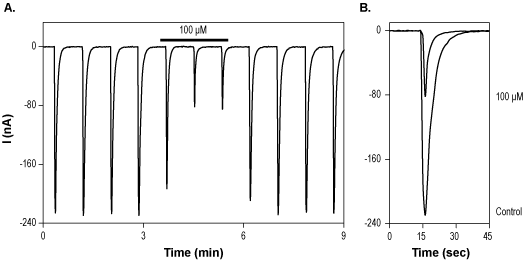Overview
- Feuerbach, D. et al. (2010) Eur. J. Pharmacol. 637, 46.
 Alomone Labs DL-AP5 inhibits NMDA (NR1+NR2A) channels expressed in Xenopus oocytes.A. Time course of NMDA currents were elicited by stimulation with 100 µM glutamate every 50 sec, while membrane potential was held at -80 mV. 100 µM DL-AP5 (#D-140), applied for 2 min, reversibly inhibited current amplitude. B. Superimposed current traces taken from experiment in A.
Alomone Labs DL-AP5 inhibits NMDA (NR1+NR2A) channels expressed in Xenopus oocytes.A. Time course of NMDA currents were elicited by stimulation with 100 µM glutamate every 50 sec, while membrane potential was held at -80 mV. 100 µM DL-AP5 (#D-140), applied for 2 min, reversibly inhibited current amplitude. B. Superimposed current traces taken from experiment in A.
- Nosyreva, E. et al. (2014) Front Mol. Neurosci. 7, 94.
- Warburton, E.C. et al. (2013) Neuropharmacology 74, 41.
- Ambert, N. et al. (2010) Open Access Bioinformatics 2, 113.
- Debski, E.A. et al. (1991) J. Neurosci. 11, 2947.
DL-2-Amino-5-phosphonovaleric acid (DL-AP5) is a selective NMDA receptor antagonist that competitively inhibits the glutamate binding site of NMDA receptors and blocks excitatory synaptic transmission.
The NMDA receptor plays important physiological and pathological roles in the central nervous system. The receptor binds the neurotransmitter L-glutamate, and meditates the majority of the fast excitatory neurotransmission in the mammalian brain. In addition, it induces current formation in neurons1.
Peripheral administration of AP5 does not cross the blood-brain-barrier and this compound may have an effect on information processing and transmission as well as plasticity2,3.
Blockade of NMDARs by AP5 has the ability to trigger synaptic potentiation in the mature hippocampus3.
Evidence shows that the inhibitory effects of AP5 are independent of membrane potential but decrease with increasing stimulation frequency3.
Several studies have suggested that chronic treatment of the optic tectum with DL-AP5 desegregates eye-specific stripes in three-eyed frogs4.
DL-AP5 (#D-140) is a highly pure, synthetic, and biologically active compound.
Applications
Citations
- Mouse brain slices (whole-cell patch clamp).
Liu, J. et al. (2019) Mol. Pharmacol. 96, 193.

